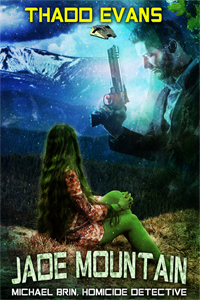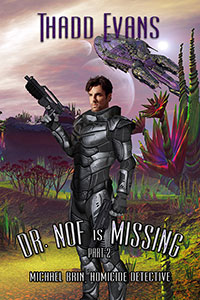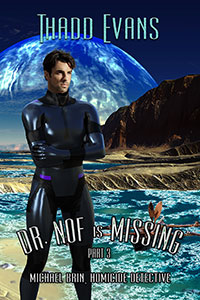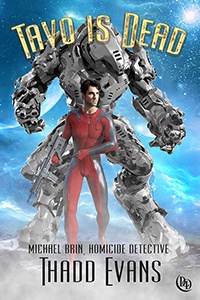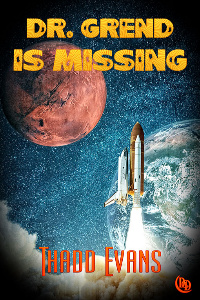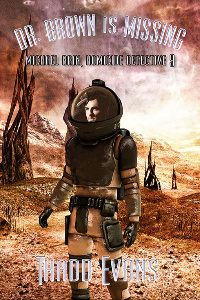Dr. Nof, a biochemist who has traveled to a moon called Barom in order to find a cure for plagues, is missing. Because dangerous beasts roam Barom’s jungles, finding her will be a challenge.
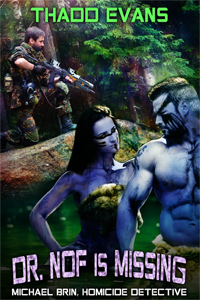
It was the year 4012. I was sitting in a café, close to Galactic Station Sixteen’s space hangar, talking to Dawn, an Aito woman with turquoise skin, a beauty I had met a few minutes ago.
She touched my hand. “Let’s go to my room for some fun.”
I nodded. My phone rang.
Tesk appeared in my contact lens. He frowned. “I have a new assignment for you. Go to the moon called Barom. A biochemist, Doctor Nof, is missing. You must find her. Your IPT leaves in six hours.”
I scowled, wanting to spend the night with Dawn.
She rubbed my thigh.
I blinked. “We can’t spend much time together.”
She cooed, “A few hours together is good enough for me.”
The IPT, or Intergalactic Personnel Transporter, went into orbit around Barom. A floor-mounted hatch opened. I went through it, entering a PPC, or Planetary Personnel Carrier, and sat next to the pilot, an Aito with a high forehead. The PPC separated from the IPT, then dropped. Tesk had given me a bag filled with seashells, all of them worth four hundred Mekos, the form of cash the indigenous Ub used.
The pilot waved his hand over a motion sensitive screen. “I’m Captain Ota. Welcome aboard.”
“Thanks. Tell me more about my next destination.”
“When we’re a few feet above the Daop Ocean, you’ll climb down a ladder onto a ship named the Foon. Its captain, Kolq, a member of the Ub race along with his crew, will take you to Yerx, the island where Doctor Nof was last seen.”
“Why don’t you take me to Yerx?”
He scowled. “If I did, our carrier would crash because of severe downdrafts in the area over and within a five mile radius of the island. We’re headed for a spot that is six miles off its west coast.”
“According to my lenses’ files, the Foon is made of wood. Why didn’t they use carbon nanotubes, steel, iron or plastic?”
“Eighteen years ago, a group of scientists from Maen, a university on Galactic Station Sixteen, sent a six inch long compressed ship called the Horizon to a location that was two thousand miles from Yerx. After a PPC dropped it in the ocean, it expanded until the vessel was forty feet long.
“The crew boarded it and set sail for Yemo, an island that was far from Yerx. During the voyage, a trip that was to last two weeks, the entire crew died. Four days after the drop, a PPC went down to check on the Horizon because its crew hadn’t transmitted or responded to emails since their arrival.
“Knowing they didn’t have the resources to figure out what killed the crew, the PPC’s crew compressed the Horizon and took the one foot long ship to an IPC. The IPC transported it to GSS. Six months later, using holograms and software, scientists discovered that the crew died because fourteen different fish species had sent hundreds of electrical shocks through the Horizon’s hull.
“After running more tests, scientists also found out the shocks would kill the crew of any ship with a hull made of iron, aluminum, or any metal.”
“What if the hull was constructed of wood and metal?”
“The scientists, a team of physicists, biologists and biochemists, conducted more tests trying to find out if a hull made of wood and different metals is safe. Forty-one thousand tests, ones including titanium, iron, stainless steel and every other metal along with every type of wood proved that even ships with a combination of materials in their hulls are unsafe when they’re on the Daop.”
“Any kind of metal? That’s odd, hard to believe.”
“Those tests proved that it’s true. A year later, scientists at Maen sent four compressed ships with plastic hulls, ones that were six inches long, to a spot that was closer to Yemo. They placed all four in the water. All of them expanded to a length of eighty feet.
“However, every vessel started falling apart after sailing around Yemo for three months. This time, a PPC heard their distress signals, picked up the crew along with all four ships, and returned them to an IPT named the Intrepid, which was bound for GSS.
“During the Intrepid’s voyage, another PPC dropped five canoes with carbon nanotube hulls along with their crew into coastal waters eight miles from Fata, an island that was three thousand miles from Yerx. After traveling around Fata for two months, all five canoes began deteriorating. Crews on all five sent distress messages to a PPC. A few hours later, it picked them and their canoes up. Within hours, an IPT took them to GSS.
“Although eight physicists, four biologists and two biochemists, all of them Maen professors, wanted to conduct more tests, several others said they figured out what happened. Viroids in the Daop destroyed the canoe’s hulls by producing strong acids.”
“What kind of acids can do this?”
“I don’t have that information. For reasons that the scientists don’t completely understand, pure wooden hulls are required on any ships that sail the Daop. They last years longer than any made of plastic or carbon nanotubes.”
I paused, surprised by this information. “Why didn’t the scientists tell the Ub about the tests?”
“Several reasons. Some believe the Ub are dumb, won’t understand what the scientists are talking about. Others think the Ub are doing fine, don’t need this information.”
I was disappointed by those scientist’s nasty attitudes and wondered if the information would help them.
“One scientist thought the Ub might be carrying viruses and bacteria, diseases that would kill many visitors from other planets, moon and space stations. In other words, people should stay away from the Ub.”
“Why haven’t the viruses and bacteria killed the Ub?”
He frowned. “They could have built up an immunity.”
“The might be carrying viruses and bacteria talk sounds like a paranoid reaction.”
He shrugged. “It’s hard to say.”

